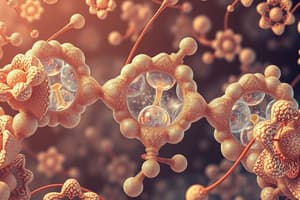Podcast
Questions and Answers
What are carbohydrates?
What are carbohydrates?
- Proteins
- Fats and oils
- Sugars and polymers of sugars (correct)
- Vitamins
What is a glycosidic bond?
What is a glycosidic bond?
A bond between the hydroxyl group of C-1 carbon of one sugar and the hydroxyl group of another.
Define metabolism.
Define metabolism.
Sum of all biochemical reactions within a cell, including anabolism and catabolism.
What is glycolysis?
What is glycolysis?
What does aerobic mean?
What does aerobic mean?
What does anaerobic mean?
What does anaerobic mean?
What is the Krebs cycle?
What is the Krebs cycle?
What is the electron transport chain?
What is the electron transport chain?
What are polysaccharides?
What are polysaccharides?
What are disaccharides?
What are disaccharides?
What is sucrose?
What is sucrose?
What is glucose?
What is glucose?
What is fructose?
What is fructose?
What are stereoisomers?
What are stereoisomers?
Define enantiomers.
Define enantiomers.
Flashcards are hidden until you start studying
Study Notes
Carbohydrates Overview
- Carbohydrates are sugars and their polymers, serving as the primary energy source for cells, and always consist of carbon (C), hydrogen (H), and oxygen (O).
Glycosidic Bond
- A glycosidic bond forms between the hydroxyl group of the C-1 carbon of one sugar and the hydroxyl group of another sugar.
Metabolism
- Metabolism encompasses all biochemical reactions within a cell, including anabolism (building up) and catabolism (breaking down) of essential biological molecules.
Glycolysis
- Glycolysis is a cellular process converting glucose or hexoses into lactate or pyruvate, reducing serum glucose levels by approximately 5-7% 1.5-2 hours after meal digestion.
Aerobic and Anaerobic Processes
- Aerobic: Occurs in the presence of oxygen, where glycolysis converts glucose to pyruvate, leading to complete oxidation into carbon dioxide (CO2) and water (H2O) while producing ATP and heat.
- Anaerobic: Occurs in the absence of oxygen, where glucose converts to pyruvate, which is then converted to lactic acid; a small amount of ATP is produced.
Krebs Cycle
- Also known as the Citric Acid Cycle or Tricarboxylic Acid Cycle, this series of reactions takes place in the mitochondria under aerobic conditions, breaking down acetyl groups from pyruvate into CO2 while generating ATP and high-energy electron carriers.
Electron Transport Chain
- Responsible for oxidative phosphorylation, this mechanism produces ATP as the main energy source for cells by extracting energy from high-energy electron carriers generated during the Krebs Cycle.
Composition of Carbohydrates
- Carbohydrates consist of carbon (C), hydrogen (H), and oxygen (O), featuring a carbonyl group (C=O) and a hydroxyl group (-OH).
Sugar Units and Hydrolysis
- Sugar units are linked via glycosidic bonds, with water produced when two carbohydrate molecules join; conversely, hydrolysis involves using water to split compounds.
Polysaccharides
- Polysaccharides contain more than two monosaccharides linked by glycosidic bonds. They can form long chains and branches.
Types of Polysaccharides
- Starch: Composed of glucose polymers, includes amylose (linear, alpha 1-4 linkages) and amylopectin (heavily branched, alpha 1-4 and 1-6 linkages).
- Glycogen: An animal polysaccharide, similar to amylopectin but more branched, primarily stored in the liver and muscle tissue.
- Cellulose: The most abundant polysaccharide, primarily in plants, with repeated glucose units bonded by beta linkages.
Disaccharides
- Comprised of two monosaccharides linked by glycosidic bonds.
- Sucrose: Table sugar, hydrolyzes to yield glucose and fructose.
- Lactose: Milk sugar, hydrolyzes to yield glucose and galactose.
- Maltose: Found in germinating grains, hydrolyzes to yield two glucose units.
Monosaccharides
- The simplest carbohydrates, consisting of a single sugar unit, with the general formula C(n)(H2O)(n). They are polar and water-soluble with significant hydroxyl group (-OH) presence.
- Glucose (C6H12O6): Aldohexose, serves as a stored carbohydrate form in the liver as glycogen.
- Fructose (C6H12O6): Ketohexose, predominantly found in fruits.
- Galactose (C6H12O6): An isomer of glucose with a different orientation of the hydroxyl group at C-4.
Monosaccharide Classifications
- Triose: Monosaccharides containing three carbons.
- Pentose: Monosaccharides containing five carbons.
- Hexose: Monosaccharides containing six carbons.
Stereoisomers and Enantiomers
- Stereoisomers: Compounds with the same bonding order but different spatial arrangements (mirror images).
- Enantiomers: A pair of nonsuperimposable mirror image stereoisomers, resulting in chiral molecules due to their 3-D atomic arrangement. D-Glucose and L-Glucose serve as examples.
Studying That Suits You
Use AI to generate personalized quizzes and flashcards to suit your learning preferences.




